#Kyoto Gekijo
Text
2024.02.16-17 sukekiyo at Kyoto Gekijo
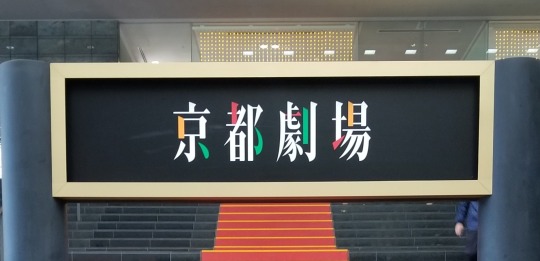
I really wanted to write about each show separately but then the 17th was filled with too many exciting things and there was no time. So I'll try about them together. And because of the setlists it also feels like they both belong together anyway.
2.16
The first day flow felt like the young idol started bright and excited, innocent, but then fell, experiencing the dirty side of love and people, but wanted to find love somehow anyway. And it finished with 呼吸・kokyuu...
As the BGM they are playing another movie (sound only).
5 minutes to and then at 6:30 the theatre buzzer sounded to signal the start of the show.
They had the usual see through screen in front of the stage (always done for the seated shows). sukekiyo and the tour name appeared as the snow was softly falling in the dark. At the same time band members walked on the stage, Takumi first, followed by Yuchi and Mika, then utA and Kyo last.
And Takumi started the piano melody of Margaret. It's so nice that they again chose to start with the last song from the previous tour, like they're creating a connection between then and now.
The stage was mostly their normal setting, but Kyo's stand had a dark bouquet laying in the middle of the table, I'm pretty sure it was the one with the doll in it that he shared in his Instagram story. There was also a high chair on the right side of his stand, right next to it.
And a new addition were big light bulbs hanging on wires over the stage, one over each band member hanging lower and four more a bit higher, nine in total. When グロス・Gloss started they lit up but dimmed when song got quieter.
During 愛した心臓・Aishita shinzo Kyo was dancing, he also came close the screen stretching his arm towards audience.
(but I'm always unsure how much they can see from the other side because of how the light works on the screen), he crouched when dancing. Kyo was very dancey, utA as well (I was sitting on utA's side that night, aisle seat though).
They all wore outfits from their last artist photos. utA's hair was more standing, full 90s visual kei style.
Kyo changed his look having a very different hairstyle. Because he shaved his head to get a new tattoo in January his hair is still very short, like in Citta he glued things on though, for sukekiyo he had two thin pink braids, one on each side, styled in a way they created two rings. And he had the porcelain doll effect make up, shiny face with drawn eyebrows, dark eye make up and full lips. The back of his dress is quite open so we could see his tattooed back. And he wore pink tabi boots to complete the look.
(you can check those tweets 1️⃣ 2️⃣ to see fans drawings of him, just pls don't repost)
Both Candis and Valentina were quite fun with the pen lights. And this part had a lot of dancey songs that even come with set dance moves... But since it was a seated show it was only Kyo dancing, with other band members rocking and jumping as well, fans had to endure and stay in their seats😂
With 口に林檎・kuchi ni ringo the stage went darker and Kyo was lit up by his mic stand's pink light. aftermath followed with the soft dark mood in the venue and the video on the screen. Some of the autumn temple has been edited and changed to pink cherry blossoms with petals scattering. Kyo sang standing by his mic stand, illuminated in pink.
And after the song ended Takumi played the piano melody that starts the session. Kyo softly walked towards the chair and sat with one leg over the other, very dignified, like a film noir singer or a diva. A black clothed staff member walked on the stage from the left side holding a make up case and started to 'do' Kyo's make up. He patted Kyo's face with a towel, he then used a sponge and a brush, then 'did' Kyo's lips. I don't think he actually changed anything but it was a part of the performance. Kyo stayed seated almost motionless through the whole process.
Then Kyo softly got up and walked to his mic stand, the session continued as Kyo joined singing. The cheerful idol from the start of the concert was gone by now, the innocence lost. The want, the hurt, the darker feelings took place to create someone new.
訪問者X・HomonshaX had Kyo dancing like a bug, very different from the way he danced as a cute idol.
It felt to me that the lights towards the end of the performance were changing between red - fiery, angry and strong - and blue - calmer and sadder, to me it felt like there was a battle of various emotions inside of our heroine. I aways have a ton of respect for Mika who is creating the visualisations for the shows.
Like during 変わってくれませんでしょうか・kawattekuremasendeshouka? when the front screen is very simple and the sides are dark with water falling over Kyo in the middle as the rain is supposed to wash everything away.
During 夢見ドロ・Yumemidoro Kyo was dancing more seductively, even wrapped his leg around the mic stand, baring it to the people. During Scarlet Kyo was pointing his lips with his index finger, 'I want you to kiss me'. Even broken things want to find love.
And at the end the acceptance came and resignation. Ending with 呼吸・kokyu had many people crying, if they were not crying by then anyway.
At the end Kyo slowly turned and left the stage. The end credits started on the screen, the audience was clapping as the rest of the band members slowly left as well. But many people kept crying even then (yours truly included).
But we did get the Gion Matsuri tour announced! 4 days at Kyoto MUSE! I wonder how many people will manage to hit all tickets on one account... I'll try😂
2.17
One more thing that was different was Kyo's stand, on the second day there were no flowers there. So I guess it was a present for his birthday?
The setlist flow was was different on this day. They started with 訪問者X・homonshaX and Kyo's bug dance. He was also pointing at the audience as he sang.
During グロス・Gloss the light bulbs lit up again. There was one moment when Kyo made a movement raising his arms like he wanted to catch his light bulp between his hands.
The video for The Hole had a mix of colours and Kyo was dancing. He definitely had more of a seductress in his movements on the second night. He stretched one arm and moved the other with the music and switched them.
The idol songs following felt quite different because of the way they started the set and the mood.
After aftermath the staff came again to 'do' Kyo's make up and it was followed up with a session. At the end the stage was quite dark with a simple spotlight on Kyo.
With 論外な生き物として・rongaina ikimono toshite I love how the song switches from soft to heavy, from Kyo carresing the mic stand softly to him headbanging.
And the hair set he had made it kinda interesting for headbanging 😆 he had thin pink braids glued to his hair again, this time the loops were shorter so the end of the brace was behind the loops. So they bounced when Kyo moved. He wore a cropped black top with puffy sleeves and strands of pearls over it. Flowy pleated black skirt and again pink tabi boots. Make up was very similar to the first night. (fan's drawing)
The rest of the band members had different outfits too. utA again had a very classic v-kei outfit, this time his hair was styled to the right side. Takumi had a long white collar outfit. Mika I couldn't see, from my seat Mika was obstructed by Kyo's iPad stand 😅 Yuchi had a sleeveless Nike top with long gloves, he changed his hair style too to add more braids.
I can't play any instruments and I don't have especially trained ears, but I'm always impressed with the sound quality at sukekiyo shows as well. I can cearly hear all instruments and they create this amazing harmony together. And I also enjoy the fact that band members use different instruments for some songs (like aftermath). I could hear the wonderful bass promised by Yuchi, Mika's powerful drums, utA's guitar, especially during solos, Takumi's piano and guitars. And Kyo's voice. 🖤
For ただ、まだ、私。・tada, mada, watashi. there was no visualisation on the screen, so it looked like there was no screen besides a bit of a smoke by the floor. There was light coming from the back of the stage and very lightly the band members silhouettes appeared above the stage. And because of this the stage appeared to be very deep.
I liked the flow of the last part of the setlist, it didn't feel as gut wrenching as the first night.
The end credits started aready during Margaret and Kyo calmly left as soon as the song ended. The rest of the band followed as fans started to give applause.
I'm so curious what we will see in Tokyo. Only one more performance left.
#sukekiyo#京都劇場#Kyoto Gekijo#attempt at live report#京#kyo#漆黒の儀#shikkoku no gi#Jet black ceremony#TOUR2024 「冷たい沈黙」
47 notes
·
View notes
Text
youtube
今日の京は、
hidden one - sukekiyo
#kyo of the day#sukekiyo#dir en grey kyo#sukekiyo takumi#sukekiyo uta#sukekiyo yuchi#sukekiyo mika#Kyoto Gekijo#2014#Youtube
5 notes
·
View notes
Text
Listening Post: Les Rallizes Dénudés

It’s difficult to paint an accurate picture of the history of Les Rallizes Dénudés, as an aura of mystery and an inordinate amount of conjecture surround the band. This we do know: Les Rallizes Dénudés sprung from the fertile music scene in late 1960s Japan, in striking opposition to the Group Sounds and folk-rock music that was popular in their country at the time. The original line-up of the band formed in 1967 at Doshisha University in Kyoto, comprising guitarist and vocalist Takashi Mizutani, guitarist Takeshi Nakamura, bassist Moriaki Wakabayashi, and drummer Takashi Katoh. They initially dubbed themselves Hadaka No Rallizes but, according to legend, after Mizutani befriended the radical theater ensemble Gendai Gekijo they became Les Rallizes Dénudés in accordance with the fake French slang that the troupe had invented.
Throughout the band’s three-decades-long existence, they cut a striking figure. Fronted by the long-haired, sunglasses-and-leather wearing Mizutani, Les Rallizes Dénudés took sensory overload to a new level. The band’s live shows were punishingly loud and replete with extreme visual elements. They had a repertoire of just over a dozen songs, but the myriad bootleg recordings that appeared in the band’s wake indicate that Mizutani and company never played a tune the same way twice. Their music seemed deceptively simple, with bass-and-drum vamps that stretched to infinity overtop of which Mizutani unfurled scorching clouds of guitar noise and vocals sung in his native Japanese.
After original bassist Wakabayashi was involved in the hijacking of a plane in 1970, the already enigmatic Mizutani became downright elusive. Outside of their iconoclastic leader, Les Rallizes Dénudés’ membership rotated frequently. Official recordings didn’t appear until 1991, at which time the band issued a trio of CDs compiled from various studio and live recordings from across the first decade of their existence. These quickly disappeared, as the legend of Les Rallizes Dénudés had grown considerably by this time, likely indirectly due to acts like High Rise and Fushitsusha that followed in their wake.
Mizutani passed away in 2019, and shortly thereafter an organization dubbed The Last One Musique appeared, complete with a new website devoted to the band. Earlier in 2022, the Temporal Drift label began issuing Les Rallizes Dénudés material, notably The Oz Tapes and the Oz Days Live compilation, supported by The Last One Musique. In November, the label plans to reissue those first three official releases – ’67-’69 Studio et Live, MIZUTANI / Les Rallizes Dénudés, and ’77 Live – completely remastered and with new liner notes that will hopefully dissolve some of the fog-like mystique surrounding the band.
We here at Dusted have varying levels of affinity for Les Rallizes Dénudés, and felt that through group discussion, we’d be able to approach the music most adroitly. Given the sheer volume of material involved (The Oz Tapes is a double LP, ’77 Live is a triple LP, and the Oz Days Live compilation is a triple CD), we chose to focus on the official releases.
I don’t know about you guys, but that ’77 Live release is what I typically associate with the Les Rallizes Dénudés “sound”. Apparently that Heavier Than a Death in the Family bootleg includes some of this material.
Intro by Bryon Hayes
youtube
Ian Mathers: So, while I'd certainly heard of them (albeit thinking they were French for a bit when all I knew was the name), my first real encounter with Les Rallizes Dénudés was only a few months ago, hearing the Heavier Than a Death in the Family version of "Night of the Assassins" and going “What is THAT?” I hadn't gotten around to investigating much further than that, though, so this Listening Post is both very convenient for me, personally, and also when I started playing '67-'69 Studio et Live and "Les Bulles de Savon / Soap Bubbles" began I was very surprised. Like you, Bryon, '77 LIVE is more what I expected, albeit on far more circumstantial grounds. And while, once I adjusted to the gentler, arguably more dated material on '67-'69 and MIZUTANI / Les Rallizes Dénudés none of it is particularly unpleasant or hard to deal with, it does suffer for me in comparison to '77 LIVE which on first listen is one of my favorite things I've heard all year, maybe longer. The 95-minute length and sheer abrasiveness of its noise means it's not going to be a casual play around my apartment, but I can honestly say I was riveted for every minute the couple of times I've been able to fit it in so far. The length of each track and of the album as a whole is part of what I think is so distinctive and incredible about it.
So if these three official/out of print releases have been around at least to some degree since the early 1990s, is the softer/folkier(?) sound of much of the studio stuff on there a big part of what people like about Les Rallizes Dénudés? I feel like once I heard more than the name I mainly heard people referring to the noisier stuff. And why did it take until this listen to realize that the bassline on what '77 LIVE calls "夜、暗殺者の夜 / The Night, Assassin’s Night" makes me think of that "I Will Follow Him" song from Sister Act?
Mason Jones: I've heard a number of people refer to Rallizes as "Japan's answer to the Velvet Underground," which rings true in part because of the bands formed in their wake. While they were never well-known, perhaps "notorious" is a better description. Their influence leaked out over years, and their shadowy presence and noisy psychedelic swirl can be traced to many independent bands. I doubt that Keiji Haino would regard them as much of an inspiration for Fushitsusha, but there's at least a visual aesthetic that's even more visible in Kousokuya and Kaneko Jutoku's work and lurks behind many other bands related to the PSF label such as Shizuka and High Rise. Some of Japan's psychedelic underground readily admit Rallizes' inspiration, such as LSD March, Up-Tight, and Overhang Party.
Where the Boredoms inspired an entire Kansai scene of anything-goes indie anarchy, Les Rallizes Denudes infiltrated a smaller but no less impactful network of smoke-drenched psychedelic players. The heavier, noisier aspect of Rallizes is better-known outside Japan, but from the deep, slow strums of Suishou no Fune to the quieter aspects of Majutsu no Niwa and LSD March, the softer side is definitely there as well. That said, I've certainly always been more attracted to their more crazed, no-holds-barred work like that on '77 LIVE and bootlegs like Blind Baby Has Its Mothers Eyes. The 1980 Live and Soundboard collection (10 CDRs!) and Double Heads boots are also among the better ones, but in truth over the years it's been nearly impossible to untangle the recordings spread across dozens and dozens of poorly assembled bootleg releases. Seeing properly mastered and collected releases coming out now is very, very welcome.
youtube
Ian Mathers: Which brings up one of the biggest questions I have about all this: how does one “properly” master something like '77 LIVE? I think it sounds fantastic, so I clearly agree with the choices made, but I wonder what's involved and what's different about working with source material like that.
Mason Jones: It's hard to say. In this case, it's possible that they have the original tapes, whereas the versions I've heard before are probably second generation or worse; very possibly duped from an old LP or cassette! However, I'm listening right now and comparing the old Le 12 Mars 1977 à Tachikawa bootleg I have, which is the same as '77 LIVE — same track lengths and all. The older bootleg feels slightly thinner and hissier, but interestingly it doesn't sound as much worse as I recalled. That one has a long history of unofficial re-releases, as shown on its Discogs page. The old bootleg I have of Mizutani is certainly improved on by the new reissue, with a great deal more clarity. I don't seem to have any previous releases that correspond to the '67 - '69 Studio et Live reissue, which is an intriguing collection of ragtag recordings.
The OZ Tapes by Les Rallizes Dénudés
Ethan Covey: It’s funny you mention mastering as there was a minor Twitter flare up a few days back when someone posted a screenshot comparing audio files from the old CD release of ’77 Live with the new edition. It looked as if the dynamic range on the new release was crunched/maxed out/whatever the correct terminology is, versus a more forgiving mix on the CD. And there was the accompanying grumbling that modern mastering — especially on a release like this — is all about volume at the expense of subtlety. I haven’t listened to the new ’77 Live yet but have to say the mastering on The OZ Tapes sounded fantastic compared with previous versions of that material. I look forward to listening to the LP (if it ever arrives), and digging into these “new” ones.
Mason Jones: Yeah, I can see that. Listening to my old CD copy versus the new one, while I haven't compared the files specifically there's certainly more modern compression on the new release. That's fairly typical these days. To my ears, it doesn't seem excessive, but it'll take more listening to let it sink in for sure. I do have to chuckle a bit about the idea of "subtlety" dealing with blown-out live recordings like these. As you say, though, I'm waiting for my LP copies to arrive, which will be a better test than mp3s.
Bryon Hayes: I have a question for Mason and those of you who've been following Les Rallizes Dénudés for some time and have access to recordings from across their existence: these three releases document a band that appears to have experienced a sizeable shift in sound in its first decade of existence, from the almost garage-y tunes of '67-'69 Studio et Live and the softer acoustic sounds of MIZUTANI to the overdriven feedback onslaught that is the '77 Live set. Does anyone know if this was a subtle transition that occurred slowly throughout the decade, or was there a Big Bang moment, with a clear delineation between those two sides of the band?
Mason Jones: That's an interesting question, Bryon. I really don't have a solid answer but can make some guesses. The sequence you list is accurate, and these three albums essentially document three phases of the band: the first lineup from '67 to '69. The acoustic work on Mizutani was him sort of on his own (with some others playing with him) during the period when there wasn't a full band. Then in 1970 he moved to Tokyo and started with a new lineup. Takeshi Nakamura, who started the band with Mizutani, was quoted as saying "The live shows were really high volume from the very beginning" so the shift from garage-y as you describe it to the more out-there tracks might have just happened naturally due to the almost complete change in band members. But who knows, perhaps some of it's simply the selection of tracks we're hearing!
youtube
Ian Mathers: I am sympathetic to "loudness war" type concerns, generally, but I have to admit the notion that the stuff here that I really like would not be brickwalled seems a little funny. Interesting to know that aside from Mizutani himself there was a pretty complete change of personnel; I still kind of wonder, given the more standard/quality production on those earlier records, how much the production, not just the playing, on '77 Live was a deliberate aesthetic choice. Do we know if it's more a case of them playing high-volume shows with recording equipment that just wasn't up to the task, in unexpectedly glorious ways, or is there any indication they were leaning into that part of their sound (whether that's using equipment a step down from what they could, or playing in certain ways, or the recording process, or mixing, or...)? Any answer isn't going to make me like that sound less, to be clear - I have no stake in this being some variety of outsider or accidental art. I do wonder if when they first heard the tapes they went "great!" or "oh no..." though.
Mason Jones: Yeah, it's hard to say whether the sound was intentional or not. In the case of the live recording, it's worth keeping in mind that in Japan it's unusual for bands to have their own equipment aside from the instruments and effects -- the live houses have amps and drums that the bands use. Since so few people drive, it's uncommon to be able to bring your own stuff. That means the amps they were using would have been the house amps, although '77 Live was recorded at Tachikawa Social Education Hall; who knows if they had a regular backline or rented equipment for the show. In any case, who knows how they felt about the tapes when they first heard them.
The overblown sound, though, was almost certainly the primary influence for Nanjo Asahito's recording and mastering approach for the first High Rise albums and later work that he did. Those recordings were infamous for the brick wall limiting, pushing everything into the red. I don't know for certain but given Nanjo's appreciation for Rallizes I'd be shocked if the sound of '77 Live wasn't the initial inspiration for that approach.
Bryon Hayes: According to the information I've scrounged online, not only was the band notoriously loud, but they were also accompanied by a frenzied lightshow, beginning with their earliest performances. Apparently Mizutani coined the term "total sensory assault" to describe the experience and it is claimed that was the goal from the start. Of course, given the amount of speculation and conjecture that surrounds the band, this could be a red herring. In some respects, I hope that as Temporal Drift release more material, the mystery will slowly unravel, but I also kind of enjoy the mystique.
32 notes
·
View notes
Text
sukekiyo lives in numbers
Since I updated my sukekiyo spreadsheet a little bit, I figured, why not share some stats. All numbers are from August 23, 2022. The October 6 live at Zepp DiverCity wasn’t counted.
Lives
Total number of lives performed: 123
2013: 2
2014: 21
2015: 21
2016: 11
2017: 14
2018: 18
2019: 11
2020: 6
2021: 8
2022: 11
Live with most debuts:
April 28, 2014 at 恵比寿LIQUIDROOM: 11 songs
Longest live:
December 31, 2019 at Shibuya Veats: 30 songs
Songs
Total number of songs performed (excluding sessions etc.): 1903
2013: 10
2014: 354
2015: 263
2016: 175
2017: 177
2018: 308
2019: 187
2020: 114
2021: 138
2022: 177
Songs with the highest number of performances (top 3):
zephyr and vandal: 63
in all weathers: 62
aftermath: 58
Songs with the lowest number of performances (top 3, excluding instrumentals & covers):
論外な生き物として (Demo Ver.): 2
Scarlet and モザイク少女: 7
The Hole: 8
Song with the highest number of subsequent yearly performances:
斑人間: 9 years (2014 to 2022)
Song with the highest number of days since its last performance (excluding instrumentals & covers):
304号室 舌と夜: 1384 days (last performed on November 8, 2018)
Songs with the longest time between live debut and official release (top 3, not counting demo versions):
304号室 舌と夜: 733 days (April 28, 2014 to April 30, 2016)
触れさせる: 675 days (February 16, 2020 to December 22, 2021)
夢見ドロ: Between 611 and 641 days (January 28, 2021 to sometime in October 2022)
It should be noted that sukekiyo performed a new song that might have been 夢見ドロ in February of 2020. If it’s indeed the same song, 夢見ドロ would befirst place with 958 to 988 days, depending on the day AMOR will be released in October.
It should also be noted that once Valentina and Sesshoku get a proper release, they will take first place. Both are currently at 966 days since their live debut with no proper release in sight.
Songs with the longest time between official release and live debut (top 3, not counting demo versions):
純朴、無垢であろうが and 首吊り遊具: 198 days (June 21, 2017 to January 5, 2018)
ガーベラ: 35 days (November 22, 2017 to December 27, 2017)
アナタヨリウエ: 11 days (May 24, 2019 to June 4, 2019)
Places
Region with the most lives:
Kanto: 55 lives
Venue with the most lives:
Kyoto Gekijo (formerly Kyoto Theater 1200): 13 lives
Other:
sukekiyo has never performed on Hokkaido and Shikoku
27 notes
·
View notes
Text
Meet All The Cast Members of World Trigger 2nd Stage Play "Large-Scale Invasion Arc"
Following the teaser visual featuring its four returning main cast members, the official website for World Trigger the Stage: Large-Scale Invasion Arc, the forthcoming second show of the stage play adaptation of Daisuke Ashihara's sci-fi action manga World Trigger, has posted individuals visuals of its all 26 cast members.
Keisuke Ueda as Yuuma Kuga
Takuya Mizoguchi as Osamu Mikumo
Arisa Sonohara as Chika Amatori
Kensuke Takahashi as Yuichi Jin
Shogo Tazuru as Reiji Kizaki
Ayano Hamaura as Kirie Konami
Shin Tamura as Kyosuke Karasuma
Rikuto Takahashi as Shun Midorikawa
Shori Kondo as Kei Tachikawa
Yuta Iiyama as Kohei Izumi
Joji Kominami as Jun Arashiyama
Misato Kawauchi as Ai Kitora
Ryota Hirono as Soya Kazama
Tsubasa Okuno as Ryo Utagawa
Hayate Miyao as Shiro Kikuchihara
Jouji Saotome as Masamune Kido
Keito Sakurai as Shuji Miwa
Kou Kanegae as Yosuke Yoneya
Kazuya Yuuki as Toru Narasaka
Shiu Sato as Shohei Kodera
Seijiro Nakamura as Hairein
Ryusei Maruyama as Enedra
Sho Arai as Lamvanein
Masakatsu Nemoto as Viza
Shogo Sakamoto as Hyuse
Tomomi Matsuba as Mira
World Trigger the Stage: Large-Scale Invasion Arc is set to be performed at Shinagawa Prince Hotel Stellar Ball in Tokyo from August 5 to 14, 2022, and at the Kyoto-Gekijo theater in Kyoto from August 19 to 21. Its story is based on the manga's fourth arc of the same name. After advance sales from may 13 to June 19, general sales of the tickets will begin on July 2.
Teaser visual:
RELATED: World Trigger 2nd Stage Play "Large-Scale Invasion Arc" Unveils Striking Cast Visuals
Source: "World Trigger the Stage" official website / Twitter
© Daisuke Asakura/Shueisha
© "World Trigger the Stage" Production Committee
By: Mikikazu Komatsu
7 notes
·
View notes
Note
Please, could you upload these live reports of sukekiyo from dates 3 and 4 in the Kyoto -Gekijo
I was not in Japan then, so I cannot write live reports of those concerts, assuming you are refering to the July 3rd and July 4th 2021 shows. However, I have read people's notes on at least the July 4th concert, such as this one (click and read the full 'thread'):
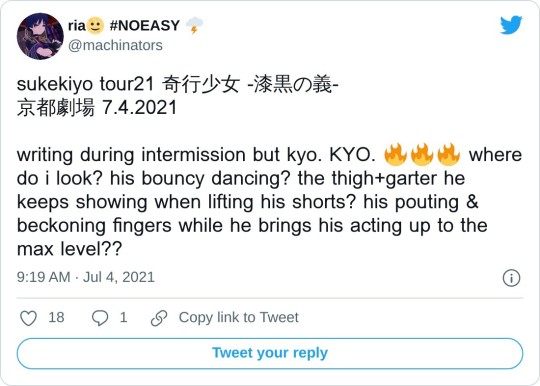
Everyone on Twitter is quite unanimous on details like that, by the way, and I don't know why tour after tour, those details do not find their way onto Tumblr too hah. I need to witness Valentina once in my life anyway, so hopefully soon!
9 notes
·
View notes
Text

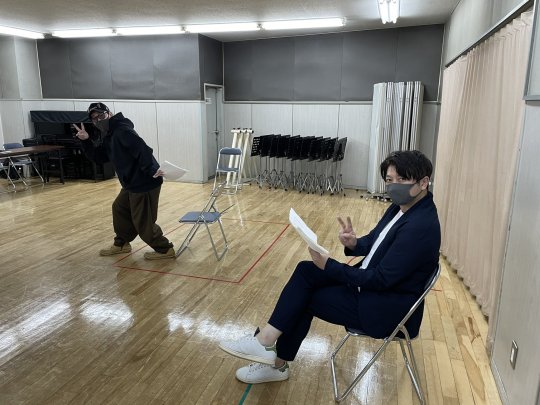
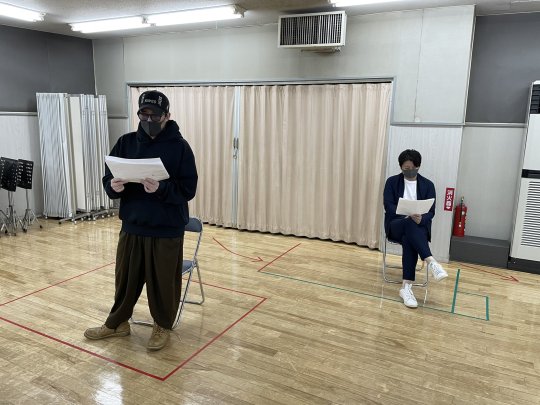
Hino Satoshi, Iwata Mitsuo and Ono Daisuke getting ready for the upcoming event Kanata presents "Triangle" ~Secret~!
Venue and dates:
- Kyoto Gekijo on September 18th and 19th;
- Yokohama LANDMARK HALL on September 25th and 26th.
Guest: Ono Daisuke, Hino Satoshi, Suganuma Hisayoshi.
Source
Official website
~Genkishi91~
#ono daisuke#hino satoshi#iwata mitsuo#kanata#kanata presents triangle secret#カナタ#カナタ presentsトライアングル~秘密~#岩田光央#小野大輔#日野聡#菅沼久義#seiyuu
7 notes
·
View notes
Photo
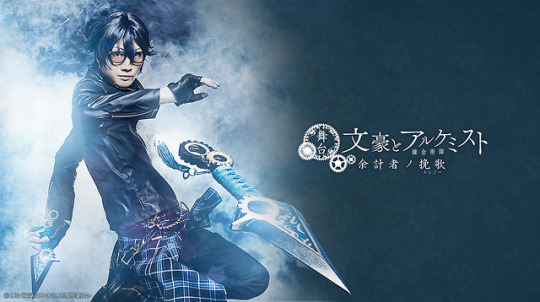


Stage Play 「Bungo to Alchemist Yokeimono no Elergy」 - Kosaka Ryoutarou as Sakaguchi Ango
Performance dates:
February 21 - 28, 2019 at Theater 1010, Tokyo
March 9 - 10, 2019, Kyoto Gekijo, Kyoto
First ticket lottery acceptance is open from November 23 to 27!
More details: http://bunal-butai.com/
#kosaka ryoutarou#translation#news#stage: bungo to alchemist#sakaguchi ango#bungo to alchemist#文豪とアルケミスト
20 notes
·
View notes
Photo
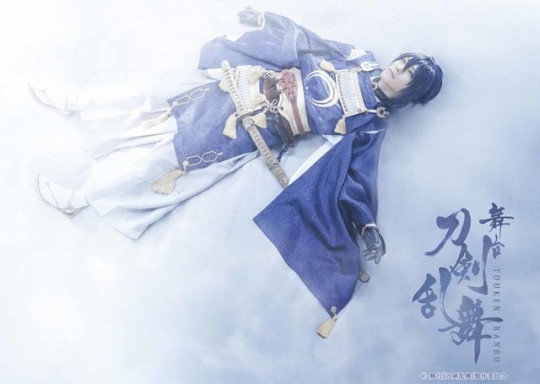
Tousute Update 2018/02/27:
Cast for the June-July 2018 Touken Ranbu Stage Play:
✧ Mikazuki Munechika: Suzuki Hiroki
✧ Yamanbagiri Kunihiro: Aramaki Yoshihiko
✧ Honebami Toushirou: Mitsuya Ryo
✧ Fudou Yukimitsu: Shiina Taizo
✧ Heshikiri Hasebe: Wada Masanari
✧ Kasen Kanesada: Wada Takuma
✧ Tsurumaru Kuninaga: Kento
✧ Shokudaikiri Mitsutada: Higashi Keisuke
✧ Daihannya Nagamitsu: Kawakami Shota
✧ Uguisumaru: Maeyama Takahisa
✧ Ookanehira: Katou Sho
✧ Kogarasumaru: Tamaki Yuki
Show Dates:
✧ June 2 (Sat) - 6 (Wed), 2018 at Meiji-za, Tokyo
✧ June 14 (Thurs) - July 1 (Sun), 2018 at Kyoto Gekijo, Kyoto
✧ July 4 (Wed) - 6 (Fri), 2018 at Al Monee Thunk Kitakyushu Soleil Hall, Fukuoka
✧ July 19 (Thurs) - 22 (Sun), 2018 at Nippon Seinenkan Hall, Tokyo
✧ July 25 (Wed) - 29 (Sun), 2018 at The Galaxy Theatre, Tokyo
#touken ranbu#touken ranbu stage#touken ranbu stage play#suzuki hiroki#maeyama takahisa#translation#mine mine#aramaki yoshihiko#wada masanari#higashi keisuke#etal#im so happy that maechan is now a touken danshi#you dont even know#yaaaay
72 notes
·
View notes
Text

sukekiyo ohp eng 2021.11.15
The release information for the upcoming Audio & video compilation 『SALUS』 by sukekiyo has been updated
The cover artwork features an exclusive illustration by the rising new face mangaka Amahi Mori. The world view of the artists matches and merges into this unprecedented artwork. The track list has been unveiled, and it will include two new pieces of music, “Candis” and “Creeper”, along with “触れさせる -furesaseru-“, which demo tape was released in 2020. A limited edition of the Official Online Shop Only Edition 【Limited Press】 has been announced to be released simultaneously, and will come with a special CLUTCH BAG featuring the compilation cover artwork and a backstage DVD.
Preorders for the Official Online Shop Only Editions will start on Nov. 16th (Tue.), 2021 at 【GALAXY BROAD SHOP LIMITED SITE】.
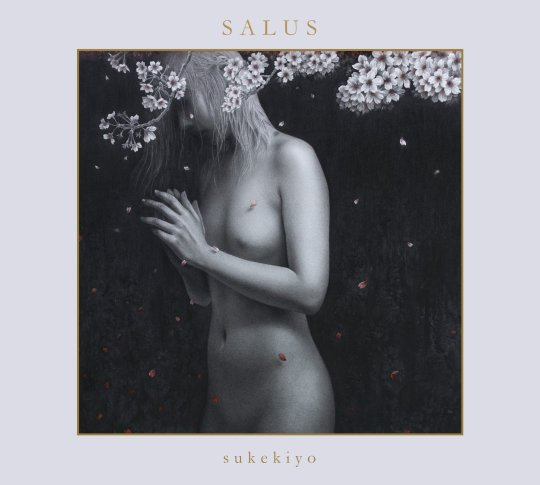
RELEASE DATE : 2021.12.22
TYPE : Official Online Shop Only Edition 【Limited Press】
PRICE : ¥11,000 (tax in)
DISC : 2 disc
FORMAT : CD+Blu-ray+CLUTCH BAG
CATALOGUE NO. : PZSK-041~042
※Bonus gift : Backstage DVD
TYPE : Official Online Shop Only Edition 【Limited Press】
PRICE : ¥6,600 (tax in)
DISC : 2 disc
FORMAT : CD+Blu-ray
CATALOGUE NO. : PZSK-041~042
【TRACK LIST】
DISC 1 [CD]
Candis
Creeper
触れさせる -furesaseru-
Candis (Off Vocal Ver.)
zephyr (Ending Ver.)
DISC 2 [Blu-ray]
Candis
Candis (Another Edition)
sukekiyo 「kikou shoujo」-Shikkoku No Gi-
2021/7/3(Sat.) Kyoto-Gekijo
2021/7/4(Sun.) Kyoto-Gekijo
aftermath
グニャ結論。そして血眼。 -gunya ketsuron. soshite chimanako.-
襞謳 -hidauta-
focus
擬似ネクロマンサー -giji necromancer-
君は剥き出し -kimi wa mukidashi-
鵠 -kugui-
※Contents, title and version are subject to change without notice.
※Available in limited numbers. Until supplies last only.
RELEASE DATE : 2021.12.29
TYPE : General Distribution Edition
PRICE : ¥1,320 (tax in)
DISC : 1 disc
FORMAT : CD
CATALOGUE NO. : PZCD-004
【TRACK LIST】
DISC 1 [CD]
Candis
触れさせる -furesaseru-
Candis (Off Vocal Ver.)
※Contents, title and version are subject to change without notice.
85 notes
·
View notes
Text
youtube
今日の京は、
focus - sukekiyo
#kyo of the day#sukekiyo#dir en grey kyo#sukekiyo takumi#sukekiyo uta#sukekiyo yuchi#sukekiyo mika#kyoto-gekijo#tour2021#Youtube
5 notes
·
View notes
Photo
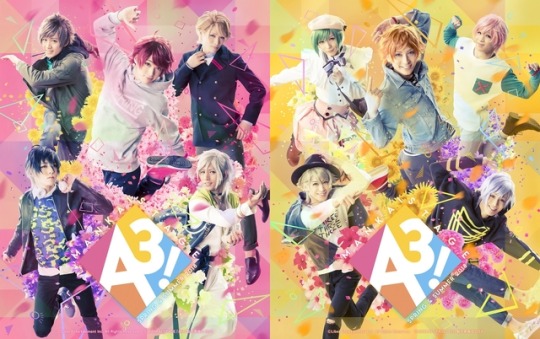
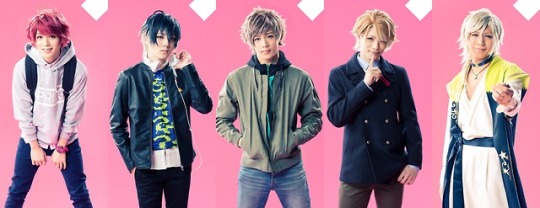
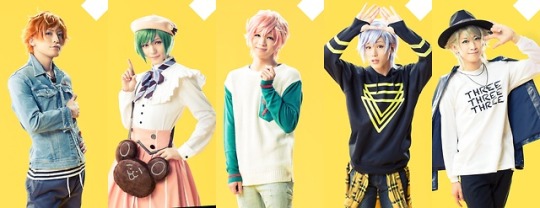
MANKAI STAGE『A3!』~SPRING & SUMMER 2018~
CAST :
SPRING TROUPE :
Yokota Ryuugi as Sakuma Sakuya
Makishima Hikaru as Usui Masumi
Maekawa Yuuki as Minagi Tsuzuru
Tateishi Toshiki as Chigasaki Itaru
Furuya Yamato as Citron
SUMMER TROUPE :
Jinnai Sho as Sumeragi Tenma
Miyazaki Yuu as Rurikawa Yuki
Noguchi Jun as Sakisaka Muku
Honda Reo as Ikaruga Misumi
Akazawa Tomoru as Miyoshi Kazunari
Takiguchi Yukihiro as Kashima Yuuzou
Taguchi Ryo as Matsukawa Isuke
Tauchi Tokihiro as Sakoda Ken
Fujita Rei as Furuichi Sakyo
DATE :
2018.06.28 - 2018.07.08 (Tokyo)
2018.07.13 - 2018.07.16 (Kyoto)
2018.10.26 - 2018.11.04 (Tokyo)
PLACE :
Galaxy Theater Tokyo
Kyoto Gekijo
Galaxy Theater Tokyo (October - November)
OFFICIAL SITE : Here
71 notes
·
View notes
Text
Touken Ranbu - Giden Akatsuki no Dokugan Ryuu (Stage Play, 2017) (Sub. Esp)
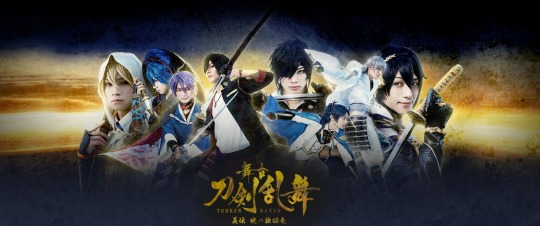
DESCARGAR O VER ONLINE AQUÍ
Título: Touken Ranbu - Giden Akatsuki no Dokugan Ryuu
Dirección: Suemitsu Keniichi
Representaciones: 1-25 junio, The Galaxy Theatre (Tokyo) - 29 junio, 2 julio, 2017, Kyoto Gekijo - 13-14 julio, 2017, Fukuoka Sunpalace
SINOPSIS
En la ciudadela, Sayo Samonji está de mal humor.
El secretario Yamanbagiri Kunihiro trata de prestar atención a sus preocupaciones, pero Sayo evita entrar en contacto con él.
En otra parte, en una misión de investigación para investigar la era Enkyou, la relación entre Ookurikara y Kasen Kanesada comienza a agriarse.
Las otras espadas de Date, Shokudaikiri Mitsutada, Tsurumaru Kuninaga y la recién manifestada Taikogane Sadamune, intentan encontrar una solución a su disputa.
Mientras consultan al maestro por consejo, Tsurumaru recibe una inesperada misión para ellos.
Mikazuki Munechika está cuidando de una ciudadela así.
Mientras tanto, en la era Sengoku, Toyotomi Hideyoshi ha logrado la unificación de Japón.
En este período de transición, un hombre se lamenta sobre el inminente final de la era Sengoku.
Ese hombre es Date Tojiro Masamune.
Su amigo ligado a él por un juramento de lealtad, Hosokawa Yoichiro Tadaoki, regaña a Masamune y le dice que acepte la era de paz en lugar de perseguir sus sueños de ser un "gran unificador."
[¿Es ser un "gran unificador" realmente "un sueño imposible" para Masamune...?]
Ese día, los Touken Danshi reciben esta orden para partir al frente.
El campo de batalla es el 5º año de la era Keichou (1600 DC): la Batalla de Sekigahara, en la que se enfrentan el ejército oriental de Tokugawa Ieyasu y el ejército occidental de Mori Terumoto e Ishida Mitsunari.
Allí, ¿los Touken Danshi vieron...?
CAST
Suzuki Hiroki como Mikazuki Munechika
Aramaki Yoshihiko como Yamanbagiri Kunihiro
Ino Hiroki como Ookurikara
Higashi Keisuke como Shokudaikiri Mitsutada
Hashimoto Shohei como Taikogane Sadamune
Kento como Tsurumaru Kuninaga
Naya Takeru como Sayo Samonji
Wada Takuma como Kasen Kanesada
Tomita Sho como Date Masamune
Saotome Jouji como Hosokawa Tadaoki
Takamatsu Jun como Katakura Kagetsuna
#touken ranbu#tourabu#stage play#touken ranbu giden akatsuki no dokugan ryuu#ino hiroki#suzuki hiroki#aramaki yoshihiko#higashi keisuke#hashimoto shohei#kento#naya takeru#wada takuma#tomita sho#saotome jouji#takamatsu jun#proyectos terminados#sub. español
5 notes
·
View notes
Photo
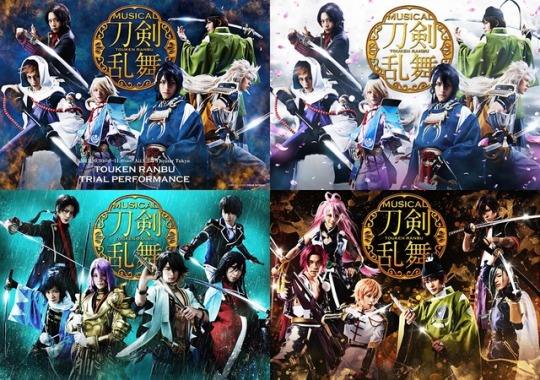


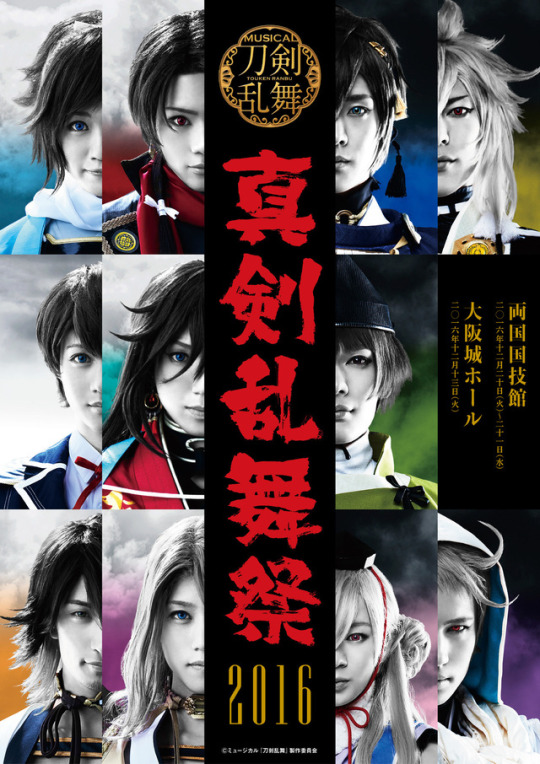
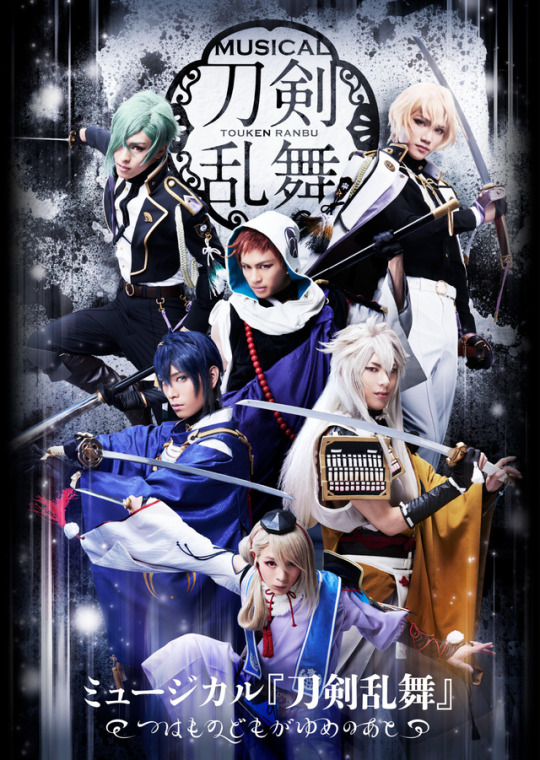

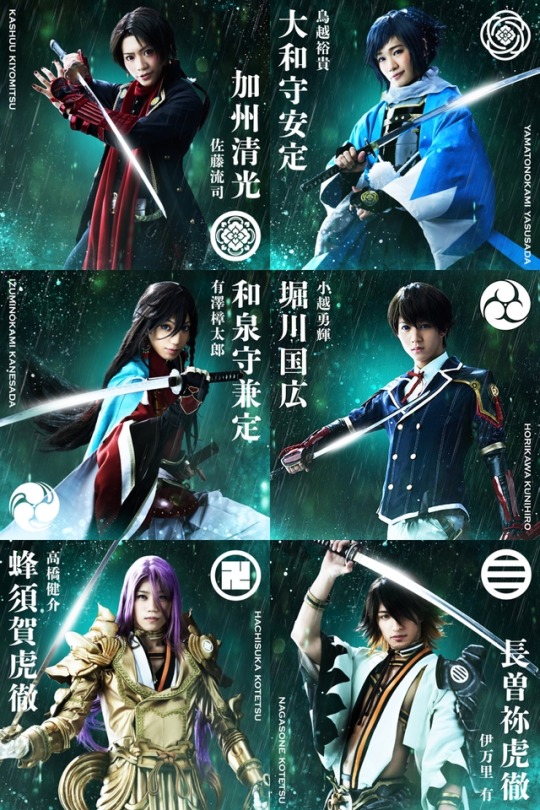


ミュージカル『刀剣乱舞』/ Musical Touken Ranbu :
Trial Performance / トライアル公演 ( Autumn 2015 )
Atsukashiyama ibun / 阿津賀志山異聞 ( Spring 2016)
Bakumatsu tenrouden / 幕末天狼傳 ( Autumn 2016 )
in Itsukushima Shrine / in 嚴島神社 ( Autumn 2016 )
Shinken Ranbu Sai 2016 / 真剣乱舞祭 2016 ( Winter 2016 )
Mihotose no Komoriuta / 三百年の子守唄 ( Spring 2017 )
Kashuu Kiyomitsu Tanki Shutsujin 2017 (Kashuu Kiyomitsu solo live) / 加州清光 単騎出陣2017 ( Autumn 2017 )
Tsuwamono domo ga yume no ato / ~つはものどもがゆめのあと~ ( Autumn 2017 )
Shinken Ranbu Sai 2017 / 真剣乱舞祭 2017 ( Winter 2017 )
Performance Dates:
Trial Performance : 17 performance within 10 days, 0 days off
Tokyo : October 30, 2015 - November 8, 2015
Atsukashiyama ibun : 40 performance within 22 days, 2 days off
Tokyo: May 27, 2016 - June 12, 2016
Osaka : June 17, 2016 - June 19, 2016
Kyoto: June 23, 2016 - June 26, 2016
Bakumatsu tenrouden : 65 performance within 39 days, 4 days off
Tokyo: September 24, 2016 - October 10, 2016
Fukuoka: October 15, 2016 - October 16
Osaka: October 21, 2016 - October 30, 2016
Tokyo: November 17, 2016 - November 27, 2016
Shanghai: January 13, 2017 - January 15, 2017
in Itsukushima Shrine : 2 performance within 1 day
November 12, 2016
Shinken Ranbu Sai 2016 : 6 performance
Osaka : December 13, 2016
Tokyo : December 20, 2016 - December 21, 2016
Mihotose no Komoriuta : 65 performance within 40 days, 5 days off
Tokyo: March 4, 2017 - March 26, 2017
Osaka : April 1, 2017- April 9, 2017
Tokyo: April 14, 2017 - April 23, 2017
Zhuhai : May 19, 2017 - May 21, 2017
Kashuu Kiyomitsu Tanki Shutsujin 2017 : 16 performance within 10 days, 1 day off
Tokyo: October 5, 2017 - October 15, 2017
Tsuwamono domo ga yume no ato : 36 performance within 24 days, 2 days off
Tokyo: November 4, 2017 - November 12, 2017
Kyoto: November 17, 2017 - November 19, 2017
Tokyo: January 6, 2018 - January 14, 2018
Osaka: January 26, 2018 - January 30, 2018
Shinken Ranbu Sai 2017 : 11 performance
Tokyo : December 8, 2017 - December 9, 2017
Osaka : December 12, 2017 - December 13, 2017
Saitama: December 19, 2017 - December 20, 2017
Guangzhou : December 23, 2017 - December 24, 2017
Place used:
Tokyo:
AiiA 2.5 Theater Tokyo : Trial Performance, Atsukashiyama ibun, Bakumatsu tenrouden, Mihotose no Komoriuta,
Ryougoku Kokugikan : Shinken Ranbu Sai 2016
Tennouzu Ginga Gekijou - The Galaxy Theatre: Kashuu Kiyomitsu Tanki Shutsujin 2017
Nippon Budokan : Shinken Ranbu Sai 2017
Tokyo Dome City Hall : Tsuwamono domo ga yume no ato
Nippon Seinenkan Hall : Tsuwamono domo ga yume no ato
Osaka:
Morinomiya Piloti Hall : Atsukashiyama ibun, Bakumatsu tenrouden
Sankei Hall Breeze: Bakumatsu tenrouden
Osakajo Hall : Shinken Ranbu Sai 2016 , Shinken Ranbu Sai 2017
Umeda Arts Theater: Mihotose no Komoriuta, Tsuwamono domo ga yume no ato
Kyoto:
Kyoto Gekijo: Atsukashiyama ibun, Tsuwamono domo ga yume no ato
Fukuoka:
Fukuoka Canal City theater: Bakumatsu tenrouden
Saitama:
Saitama Super Arena: Shinken Ranbu Sai 2017
China:
Shanghai Hongqiao Culture Artistic Center: Bakumatsu tenrouden
Zhuhai Grand Theatre : Mihotose no Komoriuta
Guangzhou Stadium: Shinken Ranbu Sai 2017
Touken Danshi Actors:
Kuroba Mario ( 黒羽麻璃央 ) as Mikazuki Munechika
Kitazono Ryo ( 北園涼 ) as Kogitsunemaru
Sakiyama Tsubasa ( 崎山つばさ) as Ishikirimaru
Saeki Daichi ( 佐伯大地 ) as Iwatooshi
Ohira Shunya ( 大平峻也 ) as Imanotsurugi
Sato Ryuji ( 佐藤流司 ) as Kashuu Kiyomitsu
Torigoe Yuuki ( 鳥越裕貴 ) as Yamatonokami Yasusada
Arisawa Shoutarou ( 有澤樟太郎 ) as Izuminokami Kanesada
Ogoe Yuuki ( 小越勇輝 ) as Horikawa Kunihiro
Takahashi Kensuke ( 高橋健介 ) as Hachisuka Kotetsu
Imari Yuu ( 伊万里有 ) as Nagasone Kotetsu
Araki Hirofumi ( 荒木宏文 ) as Nikkari Aoe
Ota Motohiro ( 太田基裕 ) as Sengo Muramasa
Spi as Tonbokiri
Yokota Ryugi ( 横田龍儀 ) as Monoyoshi Sadamune
Zaiki Takuma ( 財木琢磨 ) as Ookurikara
Miura Hiroki ( 三浦宏規 ) as Higekiri
Takano Akira ( 高野洸 ) as Hizamaru
Human Team Actors:
Atsukashiyama ibun / Trial Performance :
Tanaka Shigemi (田中しげ美) as Musashibou Benkei
Araki Kentarou (荒木健太朗) as Minamoto no Yoshitsune
Okuno Masaaki (奥野正明) as Minamoto no Yoritomo
Kako Lion (加古臨王) as Fujiwara no Yasuhira
Bakumatsu tenrouden :
Goumoto Naoya (郷本直也) as Kondou Isami
Takagi Tomohiro (高木トモユキ) as Hijikata Toshizou
Tochihara Rakuto (栩原楽人) as Okita Souji
Mihotose no Komoriuta :
Washio Noboru (鷲尾 昇) as Tokugawa Ieyasu
Ohno Mizuki (大野瑞生) as Matsudaira Nobuyasu
Ayuba Shuri (阿由葉朱凌) / Kojima Yukito (小島幸士) as Takechiyo (W cast)
Takane Masaki (高根正樹) as Gohei
Tsuwamono domo ga yume no ato:
Tanaka Shigemi (田中しげ美) as Musashibou Benkei
Araki Kentarou (荒木健太朗) as Minamoto no Yoshitsune
Tomita Masanori (冨田昌則) as Minamoto no Yoritomo
Kako Lion (加古臨王) as Fujiwara no Yasuhira
Touken Danshi Appearance:
Atsukashiyama ibun / Trial Performance :
Mikazuki Munechika
Kogitsunemaru
Ishikirimaru
Iwatooshi
Imanotsurugi
Kashuu Kiyomitsu
Bakumatsu tenrouden :
Kashuu Kiyomitsu
Yamatonokami Yasusada
Izuminokami Kanesada
Horikawa Kunihiro
Hachisuka Kotetsu
Nagasone Kotetsu
in Itsukushima Shrine :
Mikazuki Munechika
Kogitsunemaru
Ishikirimaru
Iwatooshi
Imanotsurugi
Kashuu Kiyomitsu
Yamatonokami Yasusada
Izuminokami Kanesada
Horikawa Kunihiro
Hachisuka Kotetsu
Nagasone Kotetsu
Shinken Ranbu Sai 2016 :
Mikazuki Munechika
Kogitsunemaru
Ishikirimaru
Iwatooshi
Imanotsurugi
Kashuu Kiyomitsu
Yamatonokami Yasusada
Izuminokami Kanesada
Horikawa Kunihiro
Hachisuka Kotetsu
Nagasone Kotetsu
Mihotose no Komoriuta :
Ishikirimaru
Nikkari Aoe
Sengo Muramasa
Tonbokiri
Monoyoshi Sadamune
Ookurikara
Tsuwamono domo ga yume no ato :
Mikazuki Munechika
Kogitsunemaru
Iwatooshi
Imanotsurugi
Higekiri
Hizamaru
Shinken Ranbu Sai 2017 :
Mikazuki Munechika
Kogitsunemaru
Ishikirimaru
Iwatooshi
Imanotsurugi
Kashuu Kiyomitsu
Izuminokami Kanesada
Hachisuka Kotetsu
Nagasone Kotetsu
Nikkari Aoe
Sengo Muramasa
Tonbokiri
Monoyoshi Sadamune
Ookurikara
Higekiri
Hizamaru
Other:
NHK’s Shibuya Note:
(September 4, 2016) Team Sanjou with Kashuu Kiyomitsu
(July 2, 2017) Team Shinsengumi with Hachisuka Kotetsu (without Horikawa Kunihiro, Nagasone Kotetsu)
(September 30, 2017) Formation of Mihotose
INDIA GAMING SHOW:
(February 4, 2017 - February 5, 2017) Team Shinsengumi with Hachisuka Kotetsu
Japan Expo Paris 2017:
(July 7, 2017 - July 8, 2017) Team Sanjou with Kashuu Kiyomitsu (without Mikazuki Munechika)
Music Videos:
Team Sanjou with Kashuu Kiyomitsu: 『キミの詩』 / “Kimi no Uta”
Team Shinsengumi with Hachisuka Kotetsu: 『ユメひとつ』/ “Yume Hitotsu”
Formation of Mihotose: 『勝利の凱歌』 / “Shouri no Gaika”
OFFICIAL SITE :
Here
#just some toumyu things#compilation of information?#toumyu#musical touken ranbu#touken ranbu musical#what am I missing?#I hope I didn't get any info wrong#took me a while#hahaha
177 notes
·
View notes
Text
26 Cast Members Gather in World Trigger 2nd Stage Play "Large-Scale Invasion Arc" Main Visual
Three months ahead of its opening in Tokyo, the official website for World Trigger the Stage: Large-Scale Invasion Arc, the forthcoming second show of the stage play adaptation of Daisuke Ashihara's sci-fi action manga World Trigger, has posted a main visual featuring its 26 main cat members altogether. It depicts the members of Border as they fight off a large-scale invasion launched by Aftokrator, one of the largest military powers in the Neighbor World.
『#ワールドトリガー the Stage』大規模侵攻編
メインビジュアル解禁/ #茜屋日海夏 さん& #鯨井康介 さんの声の出演が決定????
8/5(金)~14(日)品川プリンスホテル ステラボール
8/19(金)~21(日)京都劇場https://t.co/BE2SpWulvu
公演PVを公開しました????https://t.co/KP0V0xQzIW#ワーステ pic.twitter.com/M0X2LbNgUT
— 『ワールドトリガー the Stage』公式 (@W_Trigger_Stage) June 3, 2022
Also, Himika Akaneya (Laala Manaka in Idol Time Pripara) and Kosuke Kujirai (Junta Teshima in Yowamushi Pedal stage plays) are confirmed to make their voice appearance as Shiori Isami and Replica/Takumi Rindo, respectively.
World Trigger the Stage: Large-Scale Invasion Arc is set to be performed at Shinagawa Prince Hotel Stellar Ball in Tokyo from August 5 to 14, 2022, and at the Kyoto-Gekijo theater in Kyoto from August 19 to 21. Its story is based on the manga's fourth arc of the same name. After advance sales from May 13 to June 19, general sales of the tickets will begin on July 2.
Main cast:
Keisuke Ueda as Yuuma Kuga
Takuya Mizoguchi as Osamu Mikumo
Arisa Sonohara as Chika Amatori
Kensuke Takahashi as Yuichi Jin
Shogo Tazuru as Reiji Kizaki
Ayano Hamaura as Kirie Konami
Shin Tamura as Kyosuke Karasuma
Rikuto Takahashi as Shun Midorikawa
Shori Kondo as Kei Tachikawa
Yuta Iiyama as Kohei Izumi
Joji Kominami as Jun Arashiyama
Misato Kawauchi as Ai Kitora
Ryota Hirono as Soya Kazama
Tsubasa Okuno as Ryo Utagawa
Hayate Miyao as Shiro Kikuchihara
Jouji Saotome as Masamune Kido
Keito Sakurai as Shuji Miwa
Kou Kanegae as Yosuke Yoneya
Kazuya Yuuki as Toru Narasaka
Shiu Sato as Shohei Kodera
Seijiro Nakamura as Hairein
Ryusei Maruyama as Enedra
Sho Arai as Lamvanein
Masakatsu Nemoto as Viza
Shogo Sakamoto as Hyuse
Tomomi Matsuba as Mira
Teaser visual:
RELATED: World Trigger 2nd Stage Play "Large-Scale Invasion Arc" Unveils Striking Cast Visuals
Source: "World Trigger the Stage" official website / Twitter
© Daisuke Asakura/Shueisha
© "World Trigger the Stage" Production Committee
By: Mikikazu Komatsu
1 note
·
View note
Text
MANKAI STAGE『A3!』~SPRING & SUMMER 2018~ Cast Announcement
[Performance Schedule]
Tokyo: June 28th, 2018 - July 7th, 2018
Kyoto: July 13th, 2018 - July 16th, 2018
Tokyo: October 26th, 2018 - November 4th, 2018
[Theater]
Tokyo: The Galaxy Theater
Kyoto: Kyoto Gekijo Theater
Tokyo: The Galaxy Theater
[Cast]
~ Spring Troupe ~
Ryugi Yokota as Sakuya Sakuma
Hikaru Makishima as Masumi Usui
Yuuki Maekawa as Tsuzuru Minagi
Toshiki Tateishi as Itaru Chigasaki
Yamato Furuya as Citron
~ Summer Troupe ~
Sho Jinna as Tenma Sumeragi
Yu Miyazaki as Yuki Rurikawa
Jun Noguchi as Muku Sakisaka
Reo Honda as Misumi Ikaruga
Tomoru Akazawa as Kazunari Miyoshi
Yukishiro Takiguchi as Yuzo Kashima
Ryo Taguchi as Isuke Matsukawa
Tokihiro Tauchi as Ken Sakoda
Rei Fujita as Sakyo Furuichi
5 notes
·
View notes